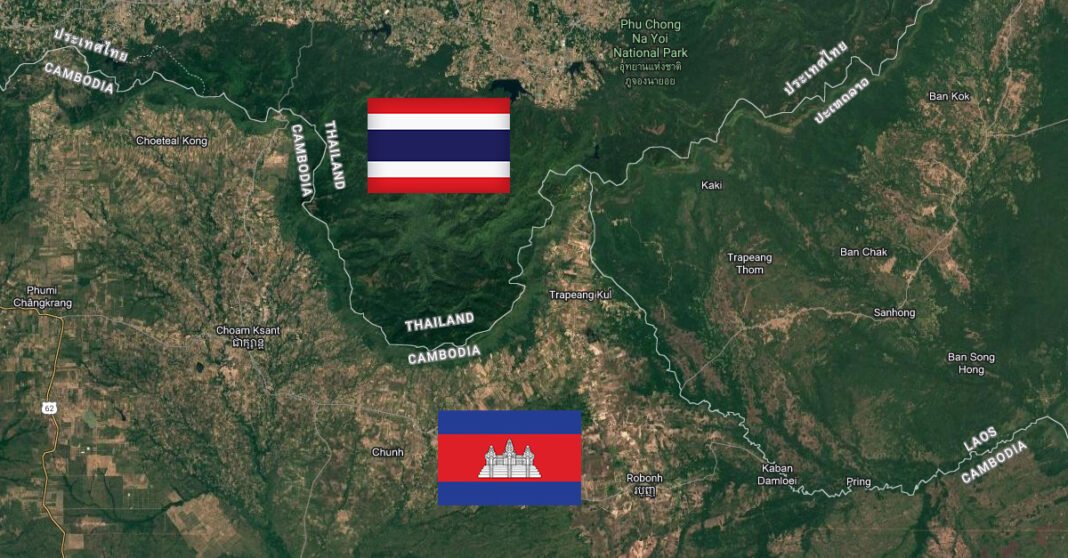The July 2025 Thai‑Cambodian border skirmishes have their roots in the colonial era of this region over a century ago. The conflict between Thailand and Cambodia was a result of a century‑long contention over the ownership of ancient temples as well as the land surrounding these temples, especially the Preah Vihear and Ta Muen Thom temples. Phu Makhuea (its Thai name) or Phnom Trap (its Khmer name) is a hill on the border of Cambodia and Thailand, close to the Temple of Preah Vihear.
It is disputed territory by both nations, and one of the central points of the 2008–2013 and 2025 border wars between Thailand and Cambodia. In the 2008 war, a request for interpretation was made to the International Court of Justice, which adjudicated that its 1962 decision, which had given sovereignty over the temple to Cambodia, could not be extended to Phnom Trap, the conflict over which would have to be resolved bilaterally. The territorial dispute goes as far back as more than a century, based on colonial boundary demarcations created by France and Siam (1907).
The rekindling of fighting was ignited on May 28, when a Cambodian soldier was fatally injured in an early morning battle between troops of both countries, in a region known as the Emerald Triangle—the border that is shared by Thailand, Cambodia, and Laos. The region is disputed because Thailand and Cambodia claim portions of it.
Both claimed the other was the aggressor: Cambodia’s Ministry of National Defense reported that the Thai army fired on a trench which was once a Cambodian army base, killing the soldier, whereas Thailand’s army reported that its troops only retaliated after the Cambodian troops “began using weapons” following a misunderstanding in the disputed zone. The Thai military seized border checkpoints, and Bangkok threatened to cut the electricity and the internet from Cambodia.
Read More: Explainer: Why Are Cambodia and Thailand Fighting?
Cambodia retaliated by restricting Thai media such as TV and film, and cutting cross‑border internet connections to Thailand. On June 17, Cambodia prohibited Thailand’s export of fresh fruits and vegetables into the country. Thailand, in turn, prohibited Thais from traveling across the border to seek work at casinos and other entertainment establishments in Cambodia’s Poipet.
Adding further fuel to the tensions, Cambodian Prime Minister Hun Manet posted on Facebook on June 16 that Cambodia wrote an official letter to the International Court of Justice to assist in resolving the border development problems. “Cambodia chooses international law and peace,” he declared the previous day.
On July 24, 2025, Thailand deployed an F‑16 fighter plane to bomb Cambodian targets on Thursday after both sides’ artillery barrages killed a minimum of 11 civilians, as border tensions boiled over into the unusual armed fighting between the Southeast Asian nations. They accused each other of initiating a morning fight at a contested section of the border, which rapidly grew from small arms fire to intense shelling.
Fighting broke out at least six places 209 km (130 miles) apart on a border. Thailand and Cambodia clashed with heavy artillery for the second consecutive day on Friday, July 25, 2025, as fighting along the border intensified and spread, while Cambodia’s ruler reported Thailand had accepted a Malaysian ceasefire plan but later went back on it. The military of Thailand said employing the use of air power was to strike precisely, while Cambodia’s foreign ministry characterized Thailand’s actions as “reckless and brutal military aggression.”
Read More: Pakistan Welcomes Thailand, Cambodia Ceasefire
The fiercest combat between the nations in 13 years followed when Thailand recalled its ambassador to Phnom Penh and threw out Cambodia’s ambassador on Wednesday, after a second Thai soldier lost a limb to a landmine that Bangkok claimed had been recently planted by competing forces. Cambodia labeled the charge as unfounded.
The recent border war between Cambodia and Thailand compelled well over 300,000 civilians to flee, ranking it as one of the worst mass evacuations in Southeast Asia in decades. In Thailand, over 138,000 individuals from provinces such as Surin, Si Sa Ket, and Ubon Ratchathani fled to emergency centers in schools and community centres. In Cambodia, tens of thousands in provinces including Oddar Meanchey fled homes under bombarding and shelling.
Noncombatants suffered the impact of violence—14 civilians and at least one soldier were reported dead by Thailand, and 8 civilians and 5 soldiers were confirmed dead by Cambodia. Several more were injured, including children as young as eight years old. Panic areas like gas stations, hospitals, schools, and marketplaces were damaged or destroyed, threatening health care, education, and livelihoods. Human Rights Watch and UN agencies issued warnings against indiscriminate employment of heavy weapons and the increasing violations of international humanitarian law, calling on both parties to secure noncombatants and civilian vital infrastructure.
A ceasefire between Thailand and Cambodia took effect at midnight (1700 GMT) on Monday, July 28, after they signed an agreement to end their deadliest battle in over a decade after five days of fierce combat. Following attempts by Malaysia, the ASEAN regional bloc chair, the United States, and China to seat both sides at the negotiating table, the leaders of the two nations agreed in talks in Putrajaya to stop fighting, resume direct communications, and establish a mechanism to enforce the ceasefire.

Udayveer Singh
Udayveer Singh is deeply interested in international relations, especially the geopolitical dynamics of South Asia. Through experiences in MUN and football, he has developed a strong sense of strategy. He enjoys exploring how global affairs unfold and how power, policy, and people interact in shaping the world around us.



